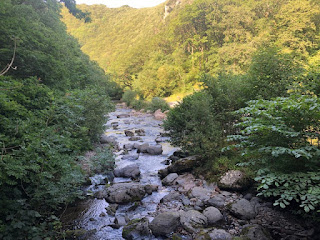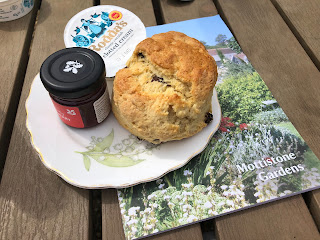John Craven has been a very important influence in my life. He was also a major influence on this blog - in fact, I would go as far as to state that John Craven saved the National Trust Scone Blog.
We began our connection, John and I, as presenter and viewer (respectively) of Newsround, where he educated me on space shuttles and giant pandas. We later moved on to otters and turnip farms when he took up the reins at Countryfile.
We began our connection, John and I, as presenter and viewer (respectively) of Newsround, where he educated me on space shuttles and giant pandas. We later moved on to otters and turnip farms when he took up the reins at Countryfile.
But back in 2013, I was going through a crisis of confidence with this National Trust Scone project. I had only just started out with it, but was almost thwarted by a) a temporary lack of internet connection in my home, which meant that I had to go to my local pub to upload my posts (thanks The Swan) b) the fact that the very first place I went to had no scones in the restaurant and c) a general feeling that it was going to be a complete waste of time.
And then, that fateful Sunday evening as I contemplated quitting, I turned on Countryfile and what did I find? John Craven was baking National Trust scones! It was like a sign from the heavens - there he was, at Watersmeet in Devon, making a right mess of Fiona the resident baker's scones. All of my doubts fell away and I have never looked back.
Ever since, Watersmeet has stood like a place of pilgrimage in my mind. Unfortunately, it was a tricky one to reach, being in North Devon. But today I finally made it there for the 180th mission on this scone quest.
As it's a momentous occasion, I will break with tradition and start with the scones. I have had numerous moments of panic over the six years of this project, usually when I've travelled 250 miles and the only baked goods in sight are shortbread and flapjacks. Today's panic was off the scale. I was late getting to Watersmeet so I almost skidded the car into a parking space and abandoned it, running down the path in the wrong shoes saying "EXCUSE ME" to bemused holidaymakers as if I was exiting Holborn Tube station at 8.45am on a Monday morning.
And then total disaster loomed: no sign of any scones in the tea room. I started to panic-formulate the sentence in my mind - "Can you put the oven back on please? I'll explain later." - when suddenly it was my turn so I just blithely asked for a cream tea. "Strawberry jam or whortleberry jam?" the woman asked. I later discovered that whortleberry is the local name for bilberry and I probably should have opted for that but at this point it was all too much for me so I played it safe.
And what a treat it was: two big plain scones, fresh as fresh could be, served with a big pot of cream. The jam always has to do more of the heavy lifting in a Devon cream tea, as neither the scone nor the cream is overly sweet. But it was divine. I could only manage one scone but it was one divine scone. I will never forget it.
And I got to eat it here - what a stunning place to eat scones:
I had given myself a pass with this blog post - I decided not to worry about the history of the place and instead just focus on lapping up the sights and sounds. But I can never resist a factoid. So here goes:
I'm going to close by going all John Peel on you. I also discovered a lovely song on Spotify called The Meeting of the Waters by Fionn Regan and it fits Watersmeet perfectly (or at least my experience of it - you might prefer Motorhead.)
In keeping with the mini surprises that Watersmeet has thrown at me since I started writing this blog post, I just looked for the video on YouTube to share it with you and it features Cillian Murphy. From John Craven to Cillian Murphy - that's the beauty of the National Trust Scone Blog. Thank God I didn't abandon it.
Watersmeet: 5 out of 5
Scones: 5 out of 5
And then, that fateful Sunday evening as I contemplated quitting, I turned on Countryfile and what did I find? John Craven was baking National Trust scones! It was like a sign from the heavens - there he was, at Watersmeet in Devon, making a right mess of Fiona the resident baker's scones. All of my doubts fell away and I have never looked back.
Ever since, Watersmeet has stood like a place of pilgrimage in my mind. Unfortunately, it was a tricky one to reach, being in North Devon. But today I finally made it there for the 180th mission on this scone quest.
As it's a momentous occasion, I will break with tradition and start with the scones. I have had numerous moments of panic over the six years of this project, usually when I've travelled 250 miles and the only baked goods in sight are shortbread and flapjacks. Today's panic was off the scale. I was late getting to Watersmeet so I almost skidded the car into a parking space and abandoned it, running down the path in the wrong shoes saying "EXCUSE ME" to bemused holidaymakers as if I was exiting Holborn Tube station at 8.45am on a Monday morning.
And then total disaster loomed: no sign of any scones in the tea room. I started to panic-formulate the sentence in my mind - "Can you put the oven back on please? I'll explain later." - when suddenly it was my turn so I just blithely asked for a cream tea. "Strawberry jam or whortleberry jam?" the woman asked. I later discovered that whortleberry is the local name for bilberry and I probably should have opted for that but at this point it was all too much for me so I played it safe.
And what a treat it was: two big plain scones, fresh as fresh could be, served with a big pot of cream. The jam always has to do more of the heavy lifting in a Devon cream tea, as neither the scone nor the cream is overly sweet. But it was divine. I could only manage one scone but it was one divine scone. I will never forget it.
And I got to eat it here - what a stunning place to eat scones:
 |
| By the rivers of Watersmeet/We ate our scones |
- Watersmeet stands at the bottom of a deep gorge where the East Lyn river meets Hoar Oak Water
- The tea room has been there since 1901!
- The National Trust took over in 1936
- The ancient oak woodland around Watersmeet contains a local species of tree called the 'No Parking Whitebeam' - that's its real name, folks. The first one of its kind was found in a layby near Watersmeet with a no parking sign nailed to it. Amazing.
I'm going to close by going all John Peel on you. I also discovered a lovely song on Spotify called The Meeting of the Waters by Fionn Regan and it fits Watersmeet perfectly (or at least my experience of it - you might prefer Motorhead.)
In keeping with the mini surprises that Watersmeet has thrown at me since I started writing this blog post, I just looked for the video on YouTube to share it with you and it features Cillian Murphy. From John Craven to Cillian Murphy - that's the beauty of the National Trust Scone Blog. Thank God I didn't abandon it.
Watersmeet: 5 out of 5
Scones: 5 out of 5
My willingness to vote for John Craven for Prime Minister: 5 out of 5










